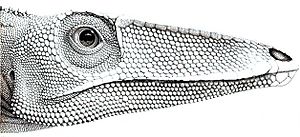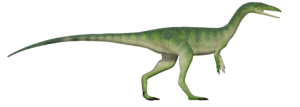Megapnosaurus facts for kids
Quick facts for kids Megapnosaurus |
|
|---|---|
 |
|
| Life restoration of the head | |
| Scientific classification |
|
| Unrecognized taxon (fix): | Megapnosaurus |
| Type species | |
| †Megapnosaurus rhodesiensis (Raath, 1969) Ivie et al., 2001
|
|
| Synonyms | |
|
|
Megapnosaurus (pronounced meg-ap-NO-sore-us) was a type of dinosaur that lived a very long time ago, about 188 million years ago, during the Early Jurassic Period. Its name means "big dead lizard" in Greek. It was a small to medium-sized dinosaur that walked on two legs and ate meat. It could grow up to about 2.2 meters (7.2 feet) long and weigh around 13 kilograms (29 pounds).
Now, let's learn more about this fascinating ancient creature!
Contents
Description
Let's imagine what Megapnosaurus rhodesiensis looked like!
- Size: It measured up to about 2.2 meters (7.2 feet) long from its nose to the tip of its tail. It weighed up to about 13 kilograms (29 pounds).
- Body Shape: It was a lean and elongated dinosaur.
- Neck: It had an S-shaped neck.
- Legs: Its hind legs were long and looked a bit like the legs of large birds, like a secretarybird. It walked on these two legs (bipedal).
- Arms: Its forelimbs (arms) were shorter than its legs. Unlike many later theropods, it had four fingers on each hand.
- Tail: It had a long tail, which likely helped it balance.
- Build: While it was lean, it was a bit more strongly built than some other dinosaurs in its group (Coelophysoidea).
Diet
Megapnosaurus might have been scavengers (eating animals that were already dead) because they thought the jaw joint was weak and the front teeth weren't strong enough to catch and hold struggling prey.
When Did They Hunt?
By comparing the size of the eye sockets (specifically, structures called scleral rings) of Megapnosaurus to those of modern birds and reptiles, scientists have suggested that Megapnosaurus might have been nocturnal, meaning they were active at night.
Discovery and History
The story of Megapnosaurus's discovery is quite interesting! The very first fossils of this dinosaur were found in 1963. A group of students from Northlea School in Zimbabwe (which was called Rhodesia back then) found them on a farm. Michael A. Raath, a scientist, was shown the fossils in 1964. Over several weeks, he and others carefully dug up the bones from rock layers called the Forest Sandstone. These rocks were from the Early Jurassic period. The main fossil found first was a well-preserved skeleton, but it was missing the skull and neck bones.
In 1968, Raath and another person found more Jurassic rocks nearby. These rocks also contained fossils of this dinosaur, though they were more broken pieces.
In 1969, Michael Raath officially named the animal Syntarsus rhodesiensis. He chose the name Syntarsus because some bones in its foot (called tarsal bones) were fused together. The "rhodesiensis" part came from Rhodesia, where it was found.
Raath kept looking for more complete skeletons. In 1972, near the Chitake River in Zimbabwe, he found an amazing spot! This quarry had hundreds of bones from at least 26 different individuals of Syntarsus rhodesiensis. This was one of the best places ever found for African theropod fossils.
The fossils from the Chitake River quarry included skulls and neck bones, which were missing before. Raath studied these fossils in great detail for his research in 1977.
All the fossils collected from these early sites are kept at the Queen Victoria Museum.
Name Change
You might be wondering why we call it Megapnosaurus now instead of Syntarsus. This happened because of a rule in science!
In 2001, scientists Ivie, Ślipiński, and Węgrzynowicz discovered that the name Syntarsus had already been used for a type of beetle. In scientific naming rules, you can't have two different animals with the exact same genus name.
Because the beetle got the name Syntarsus first, the dinosaur needed a new name. So, it was officially renamed Megapnosaurus in 2001. The species name rhodesiensis stayed the same, so its full scientific name became Megapnosaurus rhodesiensis.
Where Fossils Are Found
The main fossils of Megapnosaurus rhodesiensis have been found in two key locations:
- The Upper Elliot Formation in South Africa.
- The Forest Sandstone Formation in Zimbabwe (formerly Rhodesia), specifically at the Chitake River bonebed quarry.
The rocks where these fossils were found date back to the Hettangian stage of the Early Jurassic period, which was about 201 to 199 million years ago.
Interesting facts about Megapnosaurus
- Finding the bones of at least 30 individuals together in one place in Zimbabwe suggests that Megapnosaurus might have lived or even hunted in groups or packs.
- The fossils attributed to Megapnosaurus have been found in rock layers from different parts of the Early Jurassic period (Hettangian, Sinemurian, and Pliensbachian stages). This means the genus was either very successful and lived for a long time, or some of these fossils might belong to closely related animals that are currently grouped under the name Megapnosaurus.
- Its light and somewhat bird-like body led some early artists to show it with feathers. However, there is no direct fossil evidence that Megapnosaurus actually had feathers.
- One scientist suggested in 1988 that Megapnosaurus might have lived among desert dunes and oases.
See also
 In Spanish: Megapnosaurus para niños
In Spanish: Megapnosaurus para niños


